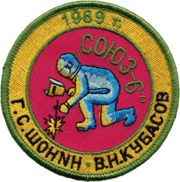Soyuz 6
| Mission type | Test flight | ||||
|---|---|---|---|---|---|
| Operator | Soviet space program | ||||
| COSPAR ID | 1969-085A | ||||
| Mission duration | 4 days, 22 hours, 42 minutes, 47 seconds | ||||
| Orbits completed | 80 | ||||
| Spacecraft properties | |||||
| Spacecraft type | Soyuz 7K-OK | ||||
| Manufacturer | Experimental Design Bureau OKB-1 | ||||
| Launch mass | 6,577 kilograms (14,500 lb) | ||||
| Crew | |||||
| Crew size | 2 | ||||
| Members |
Georgi Shonin Valeri Kubasov | ||||
| Callsign | Антей (Antey - "Antaeus") | ||||
| Start of mission | |||||
| Launch date | 11 October 1969, 11:10:00 UTC | ||||
| Rocket | Soyuz | ||||
| Launch site | Baikonur 31/6[1] | ||||
| End of mission | |||||
| Landing date | 16 October 1969, 09:52:47 UTC | ||||
| Orbital parameters | |||||
| Reference system | Geocentric | ||||
| Regime | Low Earth | ||||
| Perigee | 212 kilometers (132 mi) | ||||
| Apogee | 218 kilometers (135 mi) | ||||
| Inclination | 51.6 degrees | ||||
| Period | 88.8 minutes | ||||

| |||||
Soyuz 6 (Russian: Союз 6, Union 6) was part of a joint mission with Soyuz 7 and Soyuz 8 that saw three Soyuz spacecraft in orbit together at the same time, carrying a total of seven cosmonauts. The crew of Georgi Shonin and Valeri Kubasov were meant to take high-quality movie photography of the Soyuz 7 and Soyuz 8 docking, but the rendezvous systems on all three spacecraft failed.
It is still not known exactly what the actual problem was, but it is often quoted as being a helium pressurization integrity test.[2] The version of Soyuz 7K-OK spacecraft used for the missions carried a torus-shaped docking electronics equipment housing surrounding the motor assembly on the back of the service module, which is thought to have been pressurised with helium to provide a benign environment for the electronics. It was then jettisoned after docking to lower the mass of the spacecraft for reentry. Due to unstable temperature, disparity between the frequencies of the transmitters and receivers, which were stabilized by special quartz resonators, occurred. The piezocrystals were supposed to be in thermostats at a strictly constant temperature.[3]
The crew was made up of Shonin and Kubasov, who carried out experiments in space welding. They tested three methods: using an electron beam, a low-pressure plasma arc and a consumable electrode. While welding, Kubasov almost burned through the hull of the vehicle's Living Compartment, which in the absence of spacesuits could have resulted in a catastrophic situation.[3] The apparatus was designed at the E. O. Paton Electric Welding Institute, Kiev, Ukraine. The weld quality was said to be in no way inferior to that of Earth-based welds.[2]
After eighty orbits of the Earth, they landed on 16 October 1969, 180 km (110 mi) northwest of Karaganda, Kazakhstan.
The radio call sign of the spacecraft was Antey, referring to the Greek hero Antaeus, but at the time of the flight, however, it was also the name of the largest practicable aircraft, the Soviet Antonov 22, made in Ukraine. But unlike the call signs of Soyuz 7 and Soyuz 8, it was not the name of a squadron in Soviet military training, of uncertain role, for the one that begins with the letter 'a' is Aktif, meaning "active".
Crew
| Position | Cosmonaut | |
|---|---|---|
| Commander | Georgi Shonin First spaceflight | |
| Flight Engineer | Valeri Kubasov First spaceflight | |
Backup crew
| Position | Cosmonaut | |
|---|---|---|
| Commander | Vladimir Shatalov | |
| Flight Engineer | Aleksei Yeliseyev | |
Reserve crew
| Position | Cosmonaut | |
|---|---|---|
| Commander | Andriyan Nikolayev | |
| Flight Engineer | Georgi Grechko | |

